Restoration Techniques
Restoration of masks
This kind of restoration is possible
-
- Cracks, chips, and losses
-
Cracks are repaired and the original condition is restored. Partial chips will be repaired by applying ramie. After drying and hardening of the applied ramie, the original shape will be restored by shaving.
If the loss is large, the same material as the mask is bonded and grinded so that it is symmetrical.

-
- Re-coating
- After reinforcing with Japanese paper, the face is painted through base coating, base grinding, and top coating.

Repair Procedures
- 01Remove old paint
- Remove the paint from the mask. The paint is removed by dipping the surface in a chemical that matches the type of paint to dissolve it. In the case of painted surfaces, scrape off the paint, as washing it off with hot water may cause the wood to become distorted.
- 02Repair cracks and chips
-
There are two methods for repairing cracks in masks, depending on the type of damage. For minor cracks, scrape along the crack with a round knife or similar tool and pour resin to stop the crack.
If the crack is too deep and long, break it once. Then, make a hole on both sides of the split and stick a bamboo skewer through it to glue the two sides together. - 03Cut & shaved
-
If there are any dents shaved by the round knife, gluing marks, bumps, or gaps, they are filled in and hardened using ramie. Afterwards, the hardened ramie is shaved with a carving knife so that it takes its original shape.
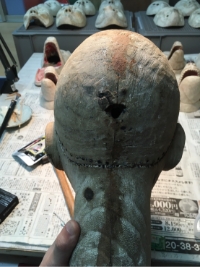
- 04Washi paste
-
The entire mask is reinforced with japanese paper.
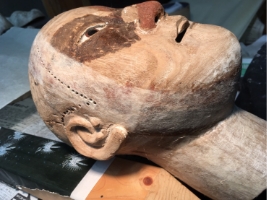
- 05Dousahiki (preparation for coating)
- Applying a liquid mixture of glue and alum to Japanese paper makes it easier for the primer to ride on the paper when applying the base coat.
- 06Paint the base coat
- Four to six coats of a base coat mixed with gofun (shell powder) and glue are applied.
- 07Groundwork sharpening
- We sharpen the groundwork faithfully so as to maximize the carving of the mask.
- 08Middle Coating
- A base coat of gofun mixed with glue is applied two or three times, thinly and carefully.
- 09Top coat
- Carefully apply three to four coats of glue and suihi paint, or glue mixed with suihi paint, to gofun (gofun).
- 10Coating polish
- The brush marks of the top coat are sharpened out in a caressing manner.
- 1111 Saisiki(coloring) (*In case of coloring finish, the process will be changed.)
- After the middle coat is applied, a coloring solution made from glue and water-dried paint is contained in a tampon, and the masks are colored as if tapping them.
- 12Finishing
-
Draw eyes, eyebrows, beards, hair, etc. with black ink.
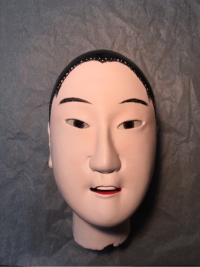
- 13Polishing
- Polish it while breathing on it.
- 1414 hairs planted
- Hair, eyebrows, and beards are planted using thin bundles of human or horse hair.

Restoration with Japanese Lacquer
-
- Peeling and crushing
-
Cracks are repaired and the original condition is restored. Partial chips will be repaired by applying ramie.
After drying and hardening of the ramie, the original shape will be restored by shaving.

-
- Re-coating
- Base coat → sharpening before undercoating → undercoat → undercoat sharpening → middle coating → middle coating sharpening → top coating → top coating sharpening → foil stamping → vermillion lacquer middle coating → vermillion lacquer top coating → face painting to finish it as if it were new.

Repair Procedures
- 01Removal of curtain and head basket
- Remove the curtain. Some of the Shishi-gashira(Lion heads) other also have bamboo baskets to wear on their heads, which are removed.
- 02Remove old paint
- Remove the paint from the mask. The paint is removed by soaking the masks in a chemical that matches the type of paint to dissolve it. In the case of the Shishi-gashira, the old paint is scraped off as much as possible, as the wood may be distorted if it is washed off with hot water.
- 03Repair of cracks
-
There are two types of repair of cracks in the Shishi-gashira, depending on the type of damage.
For minor cracks, shave along the cracks with a round or similar tool and pour resin to stop the cracks.
If the crack is too deep and long, break it once. Then, make a hole on both sides of the split and stick a bamboo skewer through it to glue the two sides together. - 04Repair of defects
-
For small defects, after making the shape with ramie, the ramie is allowed to harden and then shaped by scraping with an engraving knife.
In the case of large defects, the same material as the Shishi-gashira is used. After gluing the surfaces together by sticking bamboo skewers, the wood is carved out and the shape is sculpted. - 05Washi or linen pasting
- Reinforce the repaired cracks and defects by applying Japanese paper or rough linen.
- 06Prepping
- The entire Shishi-gashira is coated with the basecoat. Be careful not to fill in the carved areas with the primer as you apply it.
- 07Preliminary sharpening
- The base is carefully sharpened so that it can be easily primed. Especially the sculptured areas such as the eyes and wrinkles between the eyebrows are consciously sharpened to give a powerful expression to the Shishi-gashira.
- 08Paint the base coat
- After the base grinding is finished and wiped clean, black lacquer for the base coat is applied.
- 09Base Coat Polishing
- In this state, there are still grinding marks and unevenness. The surface is then carefully grinded to reduce these marks and unevenness.
- 10Middle Coat
- Black lacquer for the middle coat is applied a little thicker than the base coat.
- 11Middle Coat Polishing
-
There are still faint sharpening marks on the surface, so we will sharpen it so that the sharpening marks are completely gone.
*If there are still fine irregularities or deep grinding marks, repeat the middle coat and middle coat grinding again. - 12Gold leaf underlacquer
-
Lacquer for applying gold leaf is applied to the areas to be gilded.
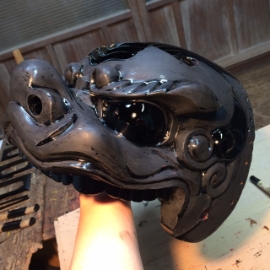
- 13Gold leaf Stamping
-
Gold leaf Stamping
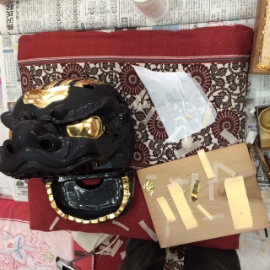
- 14Vermillion lacquered in medium
- Apply one coat of vermilion lacquer to prevent transparency.
- 15Vermilion lacquer top coating
-
Finally, apply vermilion lacquer.
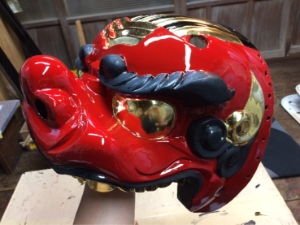
- 16Finishing
-
After the top coat of vermilion lacquer has dried thoroughly, the eyes, kumadori (shading of the eyes), and beard are painted.
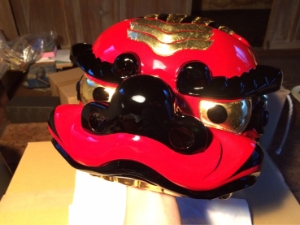
- 17Hair-planting, feather-planting
- Some Shishi-gashira(Lion heads) are planted with white hair, hemp, bird feathers, etc., so the hair and feathers are planted as before restoration.
- 18Basket and curtain installation
- The bamboo baskets and curtains, which were removed first, are attached to complete the project.

For long and beautiful use
How to care for your masks
・Dust can be brushed off lightly with a soft cloth.
・Dirt and dust that accumulate in the valleys of the sculpture will, over time, become a taste for the mask.
How to hold the mask
Please hold only the holes for the strings next to your ears with your hands.
When putting on the mask, please keep in mind that it takes two people to put on the mask, with yourself holding the mask and having someone else tie it on from behind.
If your masks get wet
Glue is water soluble and easily dissolves in water. Never rub it when wet.
Dry it in the shade and then care for it as described above.
How to preserve masks
- Storage location
-
Avoid high temperature and humidity. It may cause mold and insect infestation.
Avoid particularly dry places. Avoid storage in direct sunlight. - Boxes to be stored
- Please do not store in cardboard or other paper material boxes. The box will absorb moisture. We recommend that you use paulownia wood boxes, which regulate humidity, or a wardrobe case, which does not absorb moisture.
- How to store
-
・Please wrap the masks in soft paper.
・Cushion the space between the boxes with a soft paper-wrapped cotton ball or similar material.
・Please add insecticide* and drying material (silica gel) before putting the lid on.
*Once you start using mothballs, continue to use them thereafter. Changing the type of insecticide may cause staining.
How to care for the lion's head
After use, wipe gently with a soft, dry cloth, avoiding touching the gold leaf. Fingerprints and alcohol can cause mold.
For hard-to-remove stains, wipe with a tightly wrung cloth, then wipe with a dry cloth.
If the lion's head gets wet
Please unfold the curtain and dry it indoors in the shade.
After it dries, we hope you will care for it as described above.
How to Store Lion's Head
- Storage location
- Avoid high temperature and humidity. It may cause mold and insect infestation.
- Boxes to be stored
- Please do not store in cardboard or other paper material boxes. The box will absorb moisture. We recommend that you use paulownia wood boxes, which regulate humidity, or a wardrobe case, which does not absorb moisture.
- How to store
-
・Cushion the space between the boxes with a soft paper-wrapped cotton ball or similar material.
*Once you start using mothballs, continue to use them thereafter.
Changing the type of insecticide may cause staining.

-
Business hours/10:00~18:00
- Restoration Request

